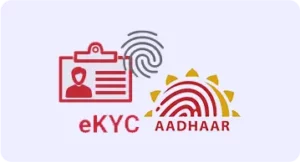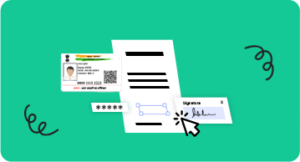Simplifying Document Signing with the Aadhaar eSign API: A Comprehensive Guide
Introduction
In today’s fast-paced digital world, electronic signatures have transitioned from being a luxury to a necessity. Among the many technological advancements that have contributed to simplifying and securing digital document signing, the Aadhaar eSign API stands as a pivotal tool. This comprehensive guide is dedicated to unraveling the intricacies of using the Aadhaar eSign API for document signing, providing you with a profound understanding of this technology and its significance in modern document management.
Section 1: Understanding the Aadhaar eSign API
The Aadhaar eSign API is a versatile and robust tool designed for the digital signing of documents. Particularly relevant in India, it utilizes unique Aadhaar credentials. This section sheds light on the key features and benefits of the API, including its legal validity, stringent security measures, and its capacity to streamline the document signing process. A grasp of the Aadhaar eSign API’s foundations is imperative for harnessing its full potential.
Section 2: Preparing for eSigning with Aadhaar eSign
Before embarking on your eSigning journey with the Aadhaar eSign API, certain fundamental prerequisites must be met, and your infrastructure should be meticulously prepared. This section lays the foundation, outlining the essential elements that must be in place for a seamless and successful eSigning experience.
- 1. Valid Aadhaar Number and Linked Mobile Number: Your first prerequisite is having a valid Aadhaar number, a unique 12-digit identification number issued by the Indian government. This number serves as a digital identity and is a cornerstone of the eSigning process. Additionally, your mobile number should be linked to your Aadhaar, enabling the delivery of a one-time password (OTP) for user verification, a critical security step in the eSigning process.
- 2. Digital Certificate from a Recognized Certifying Authority: The next critical step is obtaining a digital certificate. These certificates are issued by Certifying Authorities (CAs) and serve as digital credentials that vouch for the authenticity and identity of the certificate holder. They are pivotal for the security and validity of eSignatures. Certifying Authorities are trusted entities that verify the identity of individuals or organizations before issuing digital certificates. Using a digital certificate from a recognized CA ensures that your eSignatures are secure and legally valid.
- 3. Infrastructure Setup: Setting up your infrastructure is intricate but essential. This involves integrating the API into your existing systems and applications. It’s here that the technical elements come into play. The integration process often includes installing software development kits (SDKs) and configuring your infrastructure to ensure seamless communication with the Aadhaar eSign API. This step is mission-critical because it guarantees that your eSigning processes function smoothly, without interruptions. The robustness of this integration directly impacts the user experience and the efficiency of the eSigning process.
Section 3: Document Preparation and Integration
Proper document preparation and integration are pivotal to ensuring a seamless eSigning process with the Aadhaar eSign API.
Document Preparation:
Document preparation serves as the foundation for successful eSigning. Documents should be in a compatible format, with PDF being the most widely used format due to its reliability and consistency across various platforms. This compatibility ensures that the eSigning process can proceed without technical hindrances or format-related issues.
Security measures play an equally critical role in document preparation. Documents must be safeguarded to maintain their integrity and prevent unauthorized tampering. Implementing encryption, digital signatures, and access control measures ensures that the documents remain secure throughout the eSigning process. This is crucial for maintaining trust and ensuring that the signed documents remain valid and tamper-proof.
Integration with Aadhaar eSign API:
The integration of the Aadhaar eSign API into your existing systems and applications is a pivotal milestone in enabling seamless eSigning. This integration process typically involves the installation of software development kits (SDKs) provided by the API. The SDKs contain the necessary tools and resources to facilitate communication between your infrastructure and the Aadhaar eSign API.
Meticulous configuration of the integration is necessary to ensure that data flows smoothly between your systems and the API. The configuration sets the rules and parameters for the interaction, such as data exchange protocols and security standards. Ensuring that the integration is correctly configured is crucial for the reliability and security of the eSigning process.
Rigorous testing is indispensable to guarantee that the integration functions seamlessly. This includes testing different scenarios, user journeys, and potential points of failure. Thorough testing helps identify and rectify any issues before they impact the eSigning process, ensuring a smooth and trouble-free experience for users.
Section 4: User Authentication and Authorization
Security is a non-negotiable factor in eSigning, and the Aadhaar eSign API places a premium on ensuring the highest levels of security through rigorous user authentication and authorization processes.
User Authentication:
User authentication is a multi-step verification process designed to confirm the identity of individuals involved in the eSigning process. This process involves Aadhaar authentication. Users are required to provide their Aadhaar number, a unique 12-digit identification number issued by the Indian government. This serves as the primary digital identity for Indian citizens. To complete the authentication, users receive a one-time password (OTP) on their registered mobile number. This OTP acts as a second layer of verification, confirming that the person initiating the eSigning process is indeed the rightful owner of the Aadhaar number.
User Authorization:
Once successful authentication has taken place, the next step is user authorization. This process ensures that only legitimate users gain access to eSign documents. Unauthorized users are prevented from accessing or altering the documents. User authorization is a critical component for maintaining the security and integrity of the eSigning process.
This comprehensive authentication and authorization system ensures that only authorized individuals can execute eSignatures, adding a robust layer of security to the eSigning process. It safeguards against unauthorized access and fraudulent activities, reinforcing trust and reliability in the digital document management process.
Section 5: Executing eSignatures
With the infrastructure in place, documents prepared, and users authenticated, it’s time to delve into the actual execution of eSignatures. This section provides a comprehensive walkthrough of the eSigning process, demonstrating how the Aadhaar eSign API simplifies and streamlines the entire process.
Individual and Bulk Signing:
The Aadhaar eSign API caters to both individual and bulk signing scenarios. For individual documents, users can sign one document at a time, offering a straightforward and user-friendly experience. This is particularly useful for personal or small-scale document signing needs.
However, for scenarios where multiple documents require signatures, the API streamlines the process, enabling bulk signing. This feature is invaluable for businesses and organizations that frequently handle large volumes of documents. It saves time and simplifies the signing process by allowing users to sign multiple documents in a single batch, increasing efficiency and productivity.
Document Types and Specific Considerations:
Different document types, such as forms, contracts, and agreements, may have specific requirements or considerations for a seamless eSigning experience. The Aadhaar eSign API accommodates these variations, ensuring that the eSigning process is tailored to the specific needs of the document at hand.
This flexibility allows users to sign a wide range of document types, each with its own set of requirements. Whether it’s filling out a form, signing a contract, or approving an agreement, the Aadhaar eSign API offers a versatile and user-friendly solution for executing eSignatures across various document types.
Section 6: Legal Aspects and Compliance of Aadhaar eSign
In the ever-evolving landscape of electronic signatures, understanding the legal aspects and ensuring compliance are of paramount importance, particularly in the context of the Aadhaar eSign API.
The Aadhaar Act and Its Significance:
The Aadhaar Act, enacted by the Indian government, forms the core of the legal framework governing the use of Aadhaar credentials in various processes, including electronic signatures. It provides the legal foundation for the use of Aadhaar in electronic signatures, thereby validating their authenticity and legality.
Compliance with Government Standards:
Compliance with government standards and guidelines is not merely a formality. It’s a fundamental pillar for ensuring that eSignatures executed using the Aadhaar eSign API hold up in a court of law. Failure to adhere to these standards could lead to disputes, invalid signatures, and legal challenges.
Building Trust and Credibility:
Beyond the legal necessity, aligning your eSigning processes with these regulations is essential for building trust and credibility. It’s about assuring your clients, partners, and users that their documents are handled with the utmost care, security, and adherence to the law. Trust and credibility, once established, can be easily eroded; therefore, ensuring that your eSigning practices comply with the law reinforces the reliability and legitimacy of your digital document management processes.
Section 7: Best Practices and Tips
Optimizing your eSigning process goes beyond mastering the technical aspects; it’s also about adhering to best practices and practical tips.
User Training:
Efficient user training ensures that individuals can navigate and use the eSign system effectively, minimizing errors and enhancing productivity.
Data Security:
Robust data security measures are imperative. They help protect user data and the integrity of signed documents, fostering trust and confidentiality.
Regular Updates:
Staying informed about changes and improvements to the API is crucial. Regular updates ensure that your eSigning process remains seamless, efficient, and up-to-date with evolving standards and regulations.
Section 8: Future Developments and Trends
The world of eSignatures is a dynamic landscape, constantly evolving to meet the demands of an ever-changing digital environment.
Emerging Trends:
Blockchain Integration: Integrating blockchain technology for enhanced security, transparency, and traceability is a trend to watch. Blockchain ensures the immutability of signed documents, bolstering trust in eSignatures.
Biometric Authentication: Biometric data, such as fingerprints or facial recognition, is gaining popularity as a means of user authentication, enhancing security and user convenience.
Potential Future Developments:
Wider Acceptance: As eSignatures continue to prove their efficiency and security, more government and private institutions may adopt them as the standard, making eSignatures a widely accepted practice.
Enhanced User Experience: The user experience in eSigning interfaces is likely to witness ongoing enhancements. User-friendly interfaces, intuitive navigation, and features that make eSigning an effortless process are expected to become more prevalent.
Section 9: MSB Docs Aadhaar eSigning
When it comes to making the most of the Aadhaar eSign API for seamless and secure document signing, MSB Docs emerges as a leading solution provider.
Easy Integration:
MSB Docs seamlessly integrates with the Aadhaar eSign API, simplifying the eSigning process for users.
Compliance:
MSB Docs ensures that your eSignatures are fully compliant with the Aadhaar Act and other relevant regulations, eliminating legal concerns.
Security:
Data and document security are top priorities for MSB Docs, implementing rigorous security measures to protect your sensitive information.
Conclusion
In conclusion, the Aadhaar eSign API has transformed the way documents are signed in the digital age. This guide has delved into the core aspects of this API, covering its features, legal implications, and potential future developments. With MSB Docs, you can harness the power of the Aadhaar eSign API to streamline your document signing processes. We encourage you to take the next step and experience the convenience of Aadhaar eSigning with MSB Docs. Whether you book a demo or opt for a free trial, you’ll discover the ease of document management in the digital era, setting new standards for efficiency and security.
FAQs
1. Is Aadhaar eSign legally valid for all types of documents?
Aadhaar eSign is legally valid for various types of documents, including contracts, agreements, and forms. However, it’s essential to ensure that the specific document type is compatible with eSignatures and complies with the legal framework.
2. What are the security measures in place to protect eSign documents?
Security is a top priority in eSigning. The Aadhaar eSign API incorporates stringent security measures, such as user authentication, encryption, and data protection. These measures safeguard the integrity of eSign documents and protect them from unauthorized access and tampering.
3. How can I stay updated with the latest developments and trends in eSignatures?
To stay informed about the latest developments and trends in eSignatures, regularly check for updates to the Aadhaar eSign API. Additionally, follow industry news and consider subscribing to relevant newsletters and forums that discuss eSigning technology.
4. Is Aadhaar eSign widely accepted across various sectors?
Aadhaar eSign is increasingly being adopted in various sectors, including government and private institutions. As eSignatures continue to prove their efficiency and security, their acceptance is growing. However, the extent of acceptance may vary depending on specific organizations and regions.
5. How can I ensure my eSigning process complies with government standards?
To ensure compliance with government standards, follow the guidelines provided by the Aadhaar Act and other relevant regulations. It’s also advisable to work with trusted service providers like MSB Docs, known for their commitment to compliance and data security.



